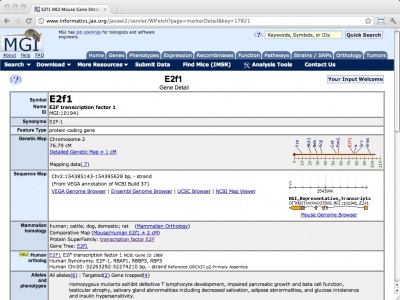Difference between revisions of "WWW MGI"
Jump to navigation
Jump to search
m |
m |
||
| Line 9: | Line 9: | ||
<section begin=abstract />The model organism database MGI (Mouse Genome Informatics) is the primary community database resource for the laboratory mouse. It integrates genomics, expression, tumor biology and metabolism information and actively curates GO annotations for mouse genes. The stated goal is to enhance the utility of mouse research for the study of human health and disease. For example, wherever available, human orthologues are cross-referenced with the respective mouse genes. The URL links to the gene details of the mouse orthologue of human E2F1. <section end=abstract /> | <section begin=abstract />The model organism database MGI (Mouse Genome Informatics) is the primary community database resource for the laboratory mouse. It integrates genomics, expression, tumor biology and metabolism information and actively curates GO annotations for mouse genes. The stated goal is to enhance the utility of mouse research for the study of human health and disease. For example, wherever available, human orthologues are cross-referenced with the respective mouse genes. The URL links to the gene details of the mouse orthologue of human E2F1. <section end=abstract /> | ||
| − | <section begin=reference />{{WWW_resource_reference_section| | + | <section begin=reference />{{WWW_resource_reference_section| }}<section end=reference /> |
<!-- DON'T EDIT BELOW --> | <!-- DON'T EDIT BELOW --> | ||
Latest revision as of 17:01, 28 January 2012
MGI (Mouse Genome Informatics) |
URL
http://www.informatics.jax.org/javawi2/servlet/WIFetch?page=markerDetail&key=17821
Abstract
The model organism database MGI (Mouse Genome Informatics) is the primary community database resource for the laboratory mouse. It integrates genomics, expression, tumor biology and metabolism information and actively curates GO annotations for mouse genes. The stated goal is to enhance the utility of mouse research for the study of human health and disease. For example, wherever available, human orthologues are cross-referenced with the respective mouse genes. The URL links to the gene details of the mouse orthologue of human E2F1.
